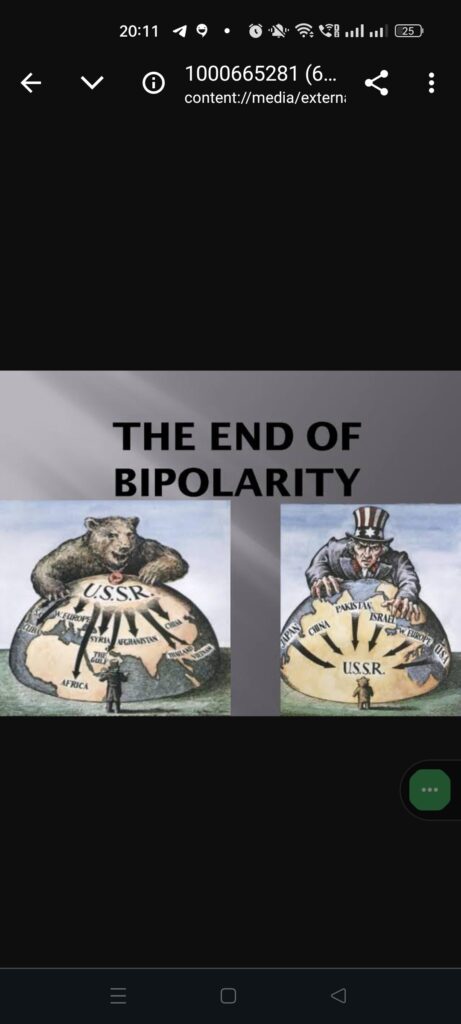The end of the Second World War led to the rise of two major canters of power.
A. USA and Germany
B. USA and USSR
C. USSR and RUSSIA
D. USA and Britain
ANS: -B
The end of the Cold War is usually seen as the beginning of ________________________.
A. Contemporary era in world politics.
B. Indian Politics.
C. Political History
D. Western Political Thought.
ANS: – A
_______________________as an ally of the Soviet Union and received both diplomatic and
financial aid from it.
A. USA
B. CUBA
C. Russia
D. Britain
ANS: – B
Who decided to convert Cuba into a Russian base?
A. American President Kennedy
B. Fidel Castro
C. Nikita Khrushchev
D. Stalin
ANS: C
In which year nuclear missiles was placed in Cuba?
A. 1962
B. 1926
C. 1965
D. 1960
ANS: – A
After how many weeks USA became aware of Missile in Cuba.
A. Four weeks
B. Two weeks
C. Three weeks
D. One week
ANS: – C
A clash seemed imminent in what came to be known as the_______.
A. Cuban Missile Crises
B. Cuban Crises
C. Missile Crises
D. Cuba Missile Crises
ANS: – A
The Cuban Missile Crises was a high point of what came to be known as the_____.
A. Hot War
B. Cold War
C. World War 1
D. World War 2
ANS: -B
_____________ referred to the competition, the tensions and a series of confrontations between the United States and Soviet Union, backed by
their respective allies.
A. Hot
B. Cold War
C. World War 2
D. Cuban Missile Crises
ANS: -B
The Cold War included_______, and ______.
A. Peace, competition and understanding.
B. Rivalries, military alliance and the balance of power.
C. Unity, competition and rivalries
D. Peace, competition and unity.
ANS: – B
Who was the president of a small island ______ nation of the United States?
A. John F Kennedy
B. Fidel Castro
C. Nikita Khrushchev
D. George Bush
ANS: – B
In which year the leaders of the Union of Soviet Socialist Republics were worried that the United States of America would invade communist-ruled
CUBA.
A. April 1961
B. April 1916
C. April 1996
D. April 1960
ANS: – A
New Internal Economic Order (NIEO) as a means of attaining and ____________________.
A. Freedom and Equality
B. Economic development
C. Political Independence
D. Both B and C
ANS: – D
The dominance of two superpowers, the of_________ and _ the
was central to the Cold War.
A. Soviet Union
B. United State of America
C. Both A and B
D. None of the above.
ANS: – C
The Cold War included_______, and _.
A. Peace, competition and understanding.
B. Rivalries, military alliance and the balance of power.
C. Unity, competition and rivalries
D. Peace, competition and unity.
ANS: – B
The Cold War was accompanied by a _______ conflict as well.
A. Monetary Conflicts
B. Ideological Conflicts
C. Personal Conflicts
D. All of the above.
ANS: – B
Who was the leader of Western Alliance?
A. US
B. Russia
C. USSR
D. Allied powers
ANS: – A
The Western Alliance represent ideology of: –
A. Socialism
B. Liberalism, democracy and Capitalism
C. Communalism
D. Marxism
ANS: – B
Who was the leader of Eastern Alliance?
A. Soviet Union
B. USA
C. Russia
D. Britain
ANS: – A
The Eastern Alliance represent the ideology of…
A. Capitalism
B. Marxism
C. Socialism and Communalism
D. Socialism and Marxism
ANS: – C
Allied forces led by the________________.
A. Germany, Italy and Japan
B. US, Soviet Union, Britain and France
C. US, Soviet Union, Italy and Japan
D. USA, USSR
ANS: – B
The World War Two spread up to which regions.
A. Asia, India, China and Burma
B. South east Asia, China, Burma and parts of India’s northeast.
C. North east Asia, China, Burma and part of India’s northeast.
D. Northeast Asia, China, Burma and parts of India’s north.
ANS: – B
Why did the critics said it was unnecessary to drop bombs?
A. Japan was innocent
B. Japan was about to surrender
C. Japan was week
D. Japan was stronger
ANS: -B
According to critics, what was the reasons for American Bombing Japan?
A. To stop the Soviet Union from making military and political gains in Asia
B. To show Moscow that the United States was supreme
C. To end the war quickly
D. Both A and B
ANS: – B
According to the US supporters have USA Dropping of the atomic bombs
was necessary to: –
A. To stop the Soviet Union from making military and political gains in Asia
B. To stop further loss of American and Allied lives.
C. To end war quickly and to stop
D. Both b and c
ANS: – D
Atomic Bomb of US on Hiroshima was code named.
A. The bomb was code-named “Little Boy”
B. Fat man
C. Little baby
D. Little girl
ANS: – A
Atomic Bomb on Nagasaki was code named as:-
A. Fat man
B. Fat boy
C. Fat women
D. Fatty man
ANS: – A
The yield of Little Boy and Fat man were _ respectively.
A. 15 and 26 kilotons
B. 15 and 29 kilotons
C. 15 and 21 kilotons
D. 14 and 21 kilotons
ANS: – C
By the early 1950s the US and the USSR were already making
thermonuclear weapons hat had a yield between________.
A. 10 and 15 kilotons
B. 10 and 15 thousand kilotons
C. 15 and 20 kilotons
D. 100 thousand kilotons.
ANS: – B
When two rival powers are in possession of nuclear weapons capable of
inflicting death and destruction un capable to each other, a full-fledged war
is
A. Unlikely
B. Likely
C. Must
D. Possible
ANS: – A
What happens in Logic of deterrence situation?
A. Both sides have the capacity to retaliate against an attack
B. Cause so much destruction that neither can afford to initiate war
C. Neither side would want to risk war
D. Both a and b
ANS: – D
In spite being an in tense form of rivalry between great powers— remained
a “cold and hot or shooting war due to?
A. Logic of War
B. Logic of peace
C. Logic of deterrence
D. All of the above
ANS:- C


